
The orange-headed thrush is a bird in the thrush family.
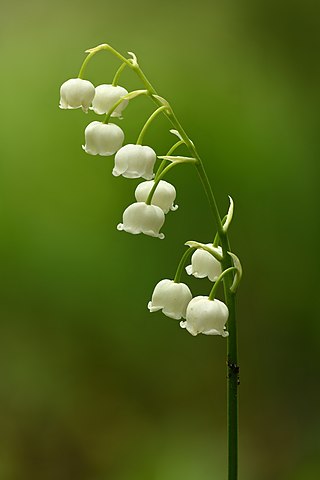
Lily of the valley, sometimes written lily-of-the-valley, is a woodland flowering plant with sweetly scented, pendent, bell-shaped white flowers borne in sprays in spring. It is native throughout the cool temperate Northern Hemisphere in Asia and Europe. Convallaria majalis var. montana, also known as the American lily of the valley, is native to North America.
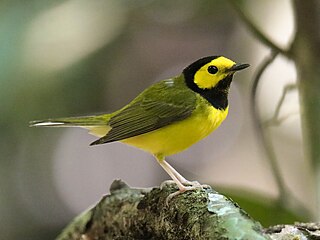
The hooded warbler is a New World warbler. It breeds in eastern North America across the eastern United States and into southernmost Canada (Ontario). It is migratory, wintering in Central America and the West Indies. Hooded warblers are very rare vagrants to western Europe.
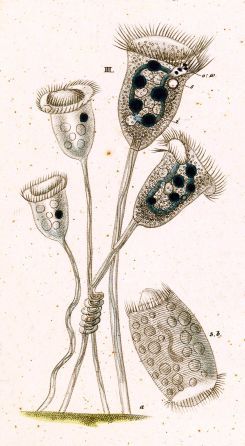
Vorticella is a genus of bell-shaped ciliates that have stalks to attach themselves to substrates. The stalks have contractile myonemes, allowing them to pull the cell body against substrates. The formation of the stalk happens after the free-swimming stage.

Amanita citrina, commonly known as the false death cap or citron amanita, is a basidiomycotic mushroom, one of many in the genus Amanita. It grows in silicate soil in the summer and autumn months. It bears a pale yellow or sometimes white cap, with white stem, ring and volva. It is an inedible mushroom due to its toxicity, but is more pertinently often confused for the lethal death cap.
Bodkin Hazel Wood is a 10.62-hectare (26.2-acre) biological Site of Special Scientific Interest (SSSI), just south of the village of Hawkesbury Upton in South Gloucestershire, notified in 1974.
A bacterivore is an organism which obtains energy and nutrients primarily or entirely from the consumption of bacteria. The term is most commonly used to describe free-living, heterotrophic, microscopic organisms such as nematodes as well as many species of amoeba and numerous other types of protozoans, but some macroscopic invertebrates are also bacterivores, including sponges, polychaetes, and certain molluscs and arthropods. Many bacterivorous organisms are adapted for generalist predation on any species of bacteria, but not all bacteria are easily digested; the spores of some species, such as Clostridium perfringens, will never be prey because of their cellular attributes.

Convallaria is a genus of flowering plants. It is usually described as a monotypic genus with the single species Convallaria majalis (lily-of-the-valley), but now some botanists distinguish up to three species, also including Convallaria keiskei and Convallaria montana.

Vorticella convallaria is a species of ciliates. It is the type species of the genus Vorticella. It resembles V. campanula, but differs in being somewhat narrow in the anterior end and usually having no refractile granules in the endoplasm.
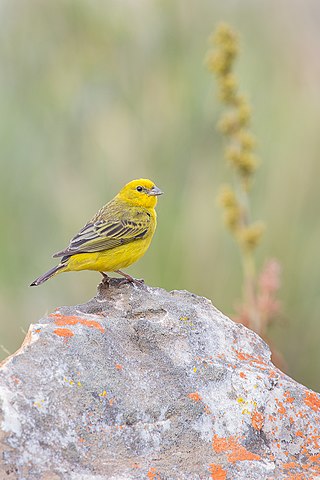
The stripe-tailed yellow finch is a species of bird in the family Thraupidae. It is found in Argentina, Bolivia, Brazil, Colombia, Guyana, Paraguay, Peru, Suriname, and Venezuela. Its natural habitats are dry savanna and pastureland.

Ctenophila is a genus of small air-breathing land snails, terrestrial pulmonate gastropod molluscs in the family Helicarionidae.
Ctenophila vorticella is a species of small air-breathing land snails, terrestrial pulmonate gastropod mollusks in the family Euconulidae, the hive snails. This species is endemic to Réunion, a French island in the Indian Ocean.
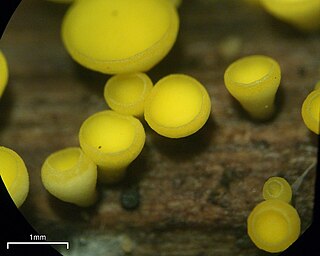
Bisporella citrina, commonly known as yellow fairy cups or lemon discos, is a species of fungus in the family Helotiaceae. The fungus produces tiny yellow cups up to 3 mm in diameter, often without stalks, that fruit in groups or dense clusters on decaying deciduous wood that has lost its bark. The widely distributed species is found in North Africa, Asia, Europe, North America, and Central and South America. Found in late summer and autumn, the fungus is fairly common, but is easily overlooked owing to its small size. There are several similar species that can in most cases be distinguished by differences in color, morphology, or substrate. Microscopically, B. citrina can be distinguished from these lookalikes by its elliptical spores, which have a central partition, and an oil drop at each end.
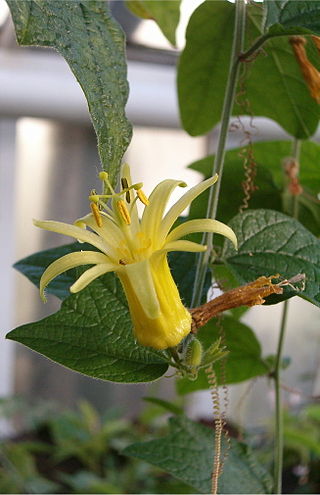
Passiflora citrina is a species of passion flower (Passiflora) native to Central America. It is also grown as an ornamental plant.
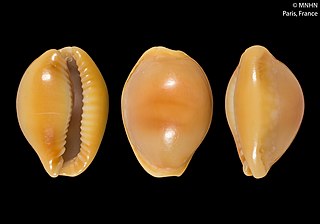
Naria citrina, common name the orange cowrie, is a species of sea snail, a cowry, a marine gastropod mollusk in the family Cypraeidae, the cowries.
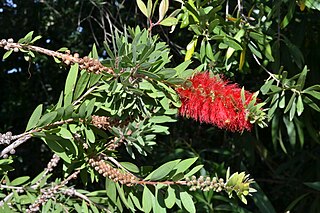
Melaleuca citrina, the common red bottlebrush, crimson bottlebrush, or lemon bottlebrush, is a plant in the myrtle family Myrtaceae, and is endemic to eastern Australia. Some Australian state herbaria continue to use the name Callistemon citrinus. It is a hardy and adaptable species, common in its natural habitat. It is widely cultivated, not only in Australia. It was one of the first Australian plants to be grown outside the country, having been taken to England in 1770 by Joseph Banks. Its showy red flower spikes, present over most of the year in an ideal situation, account for its popularity.
Molgula citrina is a species of solitary tunicate in the family Molgulidae. It is found on both sides of the northern Atlantic Ocean and in the Arctic Ocean. In 2008 it was found in Kachemak Bay in Alaska, the first time it had been detected in the Pacific Ocean.

Tholymis citrina, the evening skimmer, is a species of skimmer in the dragonfly family Libellulidae. It is found in the Caribbean Sea, Central America, North America, and South America.

Berthellina citrina, the orange gumdrop, is a species of sea slug in the family Pleurobranchidae. It is found in rock pools in the intertidal zone and in shallow water in the tropical and subtropical Indo-Pacific region.

Drosera citrina is a pygmy sundew, a type of carnivorous plant. It is native to Western Australia. The Latin specific epithet citrina means "lemon coloured", refrring to the colour of the flowers. It is closely related to Drosera nivea, which was considered a variety of D. citrina in the past called Drosera citrina var. nivea














